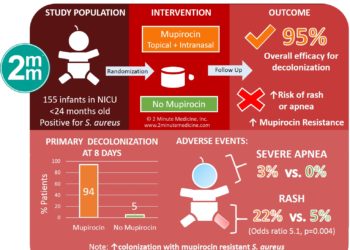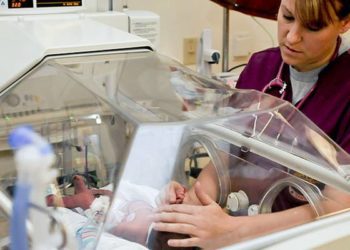Fat cell expansion protects against Staphylococcus aureus infection [PreClinical]
1. In response to infection by Staphylococcus aureus (S. aureus), dermal cell populations expanded and differentiated into adipocytes.
2. This expanding population of adipocytes produced an antimicrobial peptide called cathelicidin, which targeted the bacteria.
Evidence Rating Level: 2 (Good)
Study Rundown: The skin represents an essential component of the innate immune system by limiting infiltration of foreign pathogens. If compromised, resident cells within the dermis and epidermis release antimicrobial peptides to limit the proliferation of invading microbes and to stimulate the host immune response. Recent work has implicated adipocytes (fat cells) in regulating the innate immune response to infection, though how such protective activity occurs remained unclear.
To investigate the role of adipocytes in the immune response, this study used a model of infection in which mice received a subcutaneous injection of S. aureus. Researchers noted for the first time that a rapid expansion of the adipocyte population occurred following inoculation. In several different mouse models with impaired adipogenesis (including genetic knockout mice and pharmacological manipulation), the immune response was decreased and a more severe infection by S. aureus occurred. Further experiments showed the protective quality of the expanding adipocytes was due to their production of the antimicrobial peptide, cathelicidin. This work strongly suggests that the increase in adipocytes that occurs in response to infection has a role in limiting the spread of infection.
This study provides an explicit link between the innate immune system and adipogenesis. The research team utilized multiple models to support each claim and verified some results in humans. Although tempting to surmise that increased adiposity may be associated with resistance to infection, cathelicidin levels found in high BMI humans was much lower than concentrations resulting from infection. For clinicians, this study may highlight the importance of promoting weight gain in patients with cachexia and other immunosuppressed states.
Click to read the study in Science
Click to read an accompanying editorial in Science
Relevant Reading: Adipocytokines: mediators linking adipose tissue, inflammation, and immunity
In-Depth: In this investigation, researchers sought to understand the mechanism by which adipocytes protect against infection. Following injection of S. aureus in a mouse, the population of local adipocytes more than doubled within three days (Control: ~150 adipocytes per mm2; Infected: ~400 adipocytes per mm2; p<0.01). When adipogenesis inhibitors were applied to the infected mice, the mice became more susceptible to infection. The mouse cathelicidin (Camp) was markedly increased in adipocytes when compared to other antimicrobial peptides. The production of cathelicidin peaked 2-4 days after the onset of differentiation. When cultured with S. aureus, adipose tissue removed from Camp-/- mice did not prevent S. aureus growth. This led the researchers to develop a model whereby S. aureus infection induces adipocyte differentiation and cathelicidin production that in turn inhibits S. aureus proliferation.
To examine the link between adiposity and cathelicidin presence, the authors fed mice a high fat diet to induce obesity. They found mice fed a high fat diet had elevated levels of cathelicidin in their adipose tissue compared to mice fed a low fat diet. In human subjects, those with BMIs below 25 exhibited serum levels of cathelicidin lower than in those with BMIs greater than 25 (p<0.05). These levels were significantly lower than the protective, local concentrations driven by S. aureus infection.
More from this author: Chronic marijuana use linked to structural differences in the brain, Flavanols in cocoa may improve brain function in older adults, Gut bacteria respond to daily rhythms and influence weight control
Image: PD
©2014 2 Minute Medicine, Inc. All rights reserved. No works may be reproduced without expressed written consent from 2 Minute Medicine, Inc. No article should be construed as medical advice and is not intended as such by the authors, editors, staff or by 2 Minute Medicine, Inc.







